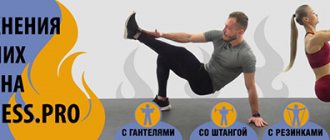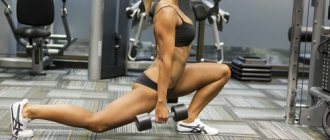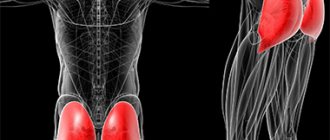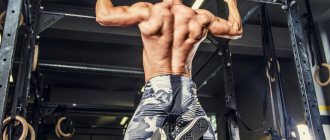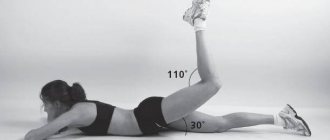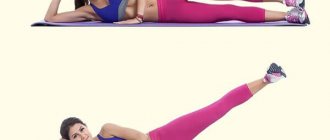Workouts using fitballs are usually associated with gymnastics for pregnant women or exercises during the recovery period after childbirth. A large ball is well suited for high-quality training of the muscles responsible for stabilizing the hips, pelvis, and spine. Suitable for people who are looking for an answer to the question of how to pump up their butt using a fitball.
The simulator was developed in the middle of the last century in Switzerland (another name is the Swiss ball) and was intended to solve problems with the musculoskeletal system. It develops the back muscles well, shapes posture, trains coordination of movements and a sense of balance. Later it turned out that the fitball is useful for everyone who decided to strengthen the core muscles, develop flexibility, slimness, and is suitable as an auxiliary exercise machine for the gluteal muscles.
Exercises for pumping up the buttocks on a gymnastic ball
Doesn't every girl or woman strive to look even better, more attractive, slimmer?
Many people try to keep up with fashion and turn to sports for help. However, choosing the most suitable direction can be complicated by various factors - work schedules that are not suitable for visiting the gym, reluctance to participate in group classes, etc. And for those who decide to discover fitness, there are ideal exercises with a fitball. This equipment increases the effectiveness of training, while simultaneously removing stress from the body. And in this article we will tell you more about exercises with a gymnastic ball and, in particular, how to pump up your butt using a fitball. Originally invented for special health-improving gymnastics, a huge elastic ball is now widely used as a sports equipment and is used in many fitness clubs.
Exercises on a fitball help to work and strengthen all the muscles of the body, correcting the figure in the right places.
Who is the training for?
Exercises with a fitball are recommended for people of all ages. For many years, the ball has been used for medical purposes for the rehabilitation of patients suffering from orthopedic diseases. A participant in regular training primarily improves physical condition, strengthens the muscles of the legs, back, abs, buttocks, inner and outer thighs. Such exercises are great for relieving stress and anxiety.
Classes are broken down like this:
- for older people (program 50+);
- special training for pregnant women, restoration of physical fitness after childbirth;
- classical, where ball exercises are included in fitness training;
- specialized programs - rehabilitation and preventive.
Balancing on a ball activates the body, strengthens the skeletal muscles responsible for maintaining correct posture, increases joint mobility, improves coordination, and helps get rid of difficulties associated with the vestibular system. The classes help people with neurological disorders. The main help for women is to shape the body: reduce the volume of the hips, make the buttocks firm, flatten the stomach, tighten the leg muscles.
Trying to control a gymnastic ball uses deep muscles that are difficult to work with other exercise machines. After a set of exercises, correct posture is formed, the woman begins to move with grace and charm, and forgets about problems with the spine.
We will describe a training program for strengthening the abs, buttocks, thighs and legs. The exercises are used for independent training.
Preparation for training
Despite the fact that the effectiveness of training with a fitball for working out the muscles of the buttocks and thighs is disputed by some, many have already been able to personally verify the effectiveness of the complex.
The thing is that training with a fitball demonstrates higher efficiency than training on a flat surface. A huge ball is indispensable when it comes to exercises that do not put stress on the spine. Fitness with a fitball helps improve your coordination in space and allows you to make your legs and butt perfect. To do this, you should choose the right size ball and regularly practice with it, performing a set of specially selected exercises.
Those who have already acquired a gymnastic ball can proceed directly to training. For those who are just thinking about purchasing a projectile, we will give some advice:
- The ball should be the right size for your height. To check this, you need to sit on the ball when purchasing. If your thighs are parallel to the floor and the angle between your shins and the back of your thighs is straight, the apparatus is perfect for you.
- When choosing a fitball, pay attention to bright colors. They will bring even more color to your workout.
- When purchasing a projectile, pay attention to the presence of an “anti-burst” system. It is indicated on the packaging as ABS or BRQ. It means that the ball can withstand quite large masses and does not burst even if punctured.
Once you have the necessary equipment, start training. If you plan to exercise at home, ventilate the room before performing a set of exercises and turn on your favorite music.
https://youtu.be/CMduE6a_n3Y
How to choose gymnastic equipment for training?
To choose the right ball for practice, you need to consider the following:
- The diameter is calculated using the following formula: Your height minus 100 centimeters;
- Having chosen the appropriate diameter, you need to sit down with your feet pressed to the floor, your thighs should be parallel to the floor and your knees perpendicular;
- bright colors will bring more positive emotions and a boost of vigor to your workout;
- Please note the presence of an anti-explosion system, designated ABS or BRQ.
If you add equipment in the form of a Swiss ball to regular exercises, they will bring more effect, help strengthen more muscle groups, and improve flexibility. Fitball for fitness is gaining more and more popularity due to the ease of training with it and the absence of contraindications. You can pump up your buttocks using a fitball only by following the correct technique and regularity. To achieve even better results, it is better to perform the entire set of exercises on a fitball, alternating them or combining them in one day.
Perform techniques in circuit training mode. After the first circuit, rest for a minute and begin a new circuit.
Simple but effective complex
After reading the list of recommendations, you can begin the lesson. It is advisable to start with a warm-up. By warming up your muscles with simple but effective exercises, you will increase the efficiency of your upcoming training and eliminate the risk of injury.
It’s probably worth starting with simpler exercises:
- Plank on a fitball. This exercise is very effective for the buttocks and back muscles, despite the fact that it is quite simple. To perform this, kneel near the ball, resting your forearms on it. As you exhale, slowly raise your knees so that your body is in a straight position. Standing in the plank position, freeze for a few seconds, then inhale and return to the starting position. All pushing movements should be accompanied by tension in the muscles of the buttocks, legs and abdominals. It is advisable to perform 5-10 repetitions of the exercise. This exercise on a fitball for the press is also very effective.
- Plank with alternating leg abductions. I.p. on a fitball - the same as when performing the previous task. Standing on straight arms, resting your palms on the floor, with your feet placed on the fitball, begin to lift them one by one. The movement is carried out due to the tension of the muscle fibers of the thighs and buttocks. Raising your leg to a height of 10-15 cm above the fitball, stay in this position for a couple of seconds, after which you can return it to its original position. Repeat the same movement with the other leg.
- "Scissors". To do this exercise, you should lie on the exercise ball with your stomach and, placing your hands on the floor in front of you, roll on the ball so that it is under your hips. Leaning on your palms, raise your legs so that they form a straight line with your body. Spread and bring your legs together in this position, imitating the work of scissors. After 10 repetitions, lower your feet to the floor, rest, and repeat the exercise 10 times. While performing the actions, keep the muscles of the legs, buttocks and abs tense.
- Squat jumps. For this exercise, you should take a fitball in your hands. Standing straight with your feet shoulder-width apart, do a squat. Hold the ball near your chest with your hands. Using the muscles of your buttocks and thighs, jump up sharply while stretching your arms with the fitball. Returning to SP, the ball should be pulled to the chest again. This exercise is very effective for the legs, as well as the inner thighs and butt.
Effective abdominal exercises
Using a fitball, you can pump up all abdominal muscle groups thanks to the following exercises:
- Sit on a fitball, rest your feet on the floor, keep your arms crossed on your chest. Gradually, using your legs, lean back.
During the exercise, your back should rest against the ball, and your knees should be under your ankles. When performing the exercise, the head is suspended, but does not tip back.
While in this position, begin to perform crunches at a slow pace, starting with the head, then involving the shoulders and back. There should be a feeling of tension in the abdominal cavity.
Do 8-10 repetitions in 2 sets. Rest between sets for about 60 seconds.
- You need to take the same position as in the previous exercise, but your hands are on the back of your head, your fingers are not crossed.
Perform in the same way as the previous one, 10 repetitions in 3 sets. The break between approaches should be reduced to 30-40 seconds.
- The starting position remains the same. There is a ball or dumbbell weighing 1-3 kg in your hands, your arms are straightened and located near your ears.
The exercise is performed with outstretched arms for 15 repetitions in 4 sets, then the number increases to 20 repetitions.
Highly efficient complex
For those who want to quickly get their figure in order, it is worth performing, in addition to the above exercises, a more effective complex for the legs, buttocks and abs:
- The glute bridge on a fitball is the most effective exercise for working the most important areas of the body. To perform it, lie on your back, place your ankles on the ball, and extend your arms along your body. Lift your knees and buttocks up so that your body forms a bridge. At the top point, emphasis is placed on the full feet and shoulder blades. After a short pause, you can return to i. P.
- Bridge with alternating leg raises. This variation of the bridge on a fitball is more complex, but also more effective for pumping up the desired muscle groups. Having taken the same position as in the previous case, with the buttocks raised, lift your legs one by one, bending them at the knees and pulling your toes away from you. The recommended number of repetitions is 15-20 times.
- Hip abduction. Standing on your knees to the side of the fitball, lean against it with your arm slightly bent at the elbow and lean your body, placing the palm of your other hand on your belt. Raise your leg up and straighten it at the same time, repeating the movement 10-15 times. Then switch sides, lifting with the other leg.
Regular exercise on a fitball is the key to high performance indicators. If you want to pump up and perfect your figure, exercises for the butt and thighs with such a ball should be done as a single set at least three days a week. For those who do not have such an opportunity, a daily workout option of 2-3 exercises on a fitball is suitable.
How to build a workout
* Start your session with a warm-up.
5-7 minutes of joint gymnastics or aerobics at an average pace will be enough.
* Build a training session based on the circular principle.
“Perform the exercises sequentially, leaving no more than 40 seconds of rest between them
.
Rest between circles - up to 60 seconds. Start by performing two circles, gradually increase their number to four,” advises Tatyana.
* Perform each exercise for 10-15 repetitions.
“Increase the load gradually,” comments Tatyana Yurina.
* Watch the execution technique.
“Bending your knees to a straight or obtuse angle will help reduce stress on your joints,” says our expert.
* Exercise 2-3 times a week.
If possible, complement these workouts with a 20-30 minute cardio session.
To complete the complex, you will need a mat and a fitball (we wrote here how to choose one).
What muscles are involved?
Let's talk about the buttocks. The gluteal muscles of our body consist of three parts:
- Large ones - located on the back surface of the pelvis and are responsible for convexity and relief;
- The middle ones are located on the sides of the pelvis and are responsible for the beautiful line of the hips;
- Small - attached next to the middle muscles and perform the same functions.
By training each of them, doing exercises for the buttocks on a fitball, you will help your butt become convex, toned and elastic.
It is important to understand that training on a fitball is not isolating. This means that in addition to the glutes, many other muscles will be involved. Below are the most effective exercises with a fitball for the buttocks, thighs, abs and lower back muscles.
Note! The size of the fitball that suits you can be calculated as your height – 100 centimeters. Having chosen the one you need, sit down on it, pressing your feet to the floor. Your thighs should be parallel to the flat surface and your knees should be at an angle of 90 degrees.
Training problem areas
For the buttocks, working out the inner and outer parts of the thighs, and legs, squats and bends are suitable, as in regular exercises. The exercises are complex, but significantly effective for modeling these problem areas:
Exercises with a fitball for problem areas are recommended to be performed comprehensively, in combination with other methods of body shaping: massage, anti-cellulite wraps, diets. You will simply fall in love with the simulator, feel the fullness of life, and leave several years behind. Daily efforts will definitely bring stunning results.
Top 3 Ball Moves for Beginners
These movements are quite simple to perform and do not require serious physical training. They are quite suitable for beginners.
Hyperextension on a fitball for the buttocks (extension in the lumbar region)
The exercise is suitable for both beginners and advanced athletes. The primary muscles involved are the iliocostal, lumbar and mid back muscles. Additionally, the gluteus maximus and hamstring muscles are tensed. The ball exercise differs from the classic hyperextension for the buttocks in that, among others, it involves many more stabilizer muscles.
Technique:
- Starting position - lie on your stomach on the ball, arms bent behind your head, legs straight with support on your toes, looking down, your back completely relaxed (as if hanging from a gymnastic apparatus);
- As you inhale, the back muscles straighten and the body stretches into one straight line, the lower back is slightly tucked so as not to overstrain it;
- As you exhale, we return to IP again.
The difficulty of these actions lies in maintaining balance and coordination.
You should start with 10 repetitions in 3 sets. You can gradually increase the number of repetitions to 20-25.
Be sure to watch the video before starting the lesson:
https://youtu.be/Ezz9BAw-v1Q
Important! Before any sports activities, ALWAYS do a warm-up!
Wall Squats
The work is aimed at working out the butt and the front of the thigh. The difficulty is easy; if you wish, you can weigh yourself down with dumbbells or do squats on one leg. There are 7 more types of squats for the gluteal muscles; special attention should be paid to squats with dumbbells.
Technique:
- The starting position is to stand with your back to the wall and press the ball tightly against it with your lower back. The legs are set slightly forward and shoulder-width apart;
- Tighten your abs, take a breath and, keeping your balance, squat down, your thighs should be parallel to the floor. Stay at the bottom point for a few seconds , feeling all the tension in the buttocks;
- As you exhale, return to the starting position.
The ball should roll up and down along your spine. Be sure to watch your lower back; it should be pressed tightly against the gymnastic instrument. For greater load, perform this exercise with dumbbells.
You need to do 15-20 repetitions for 3-5 approaches.
Find out more information from the video:
https://youtu.be/xnN0U-a-_MY
One of the simplest exercises with a gymnastic ball is jumping on a fitball for the buttocks. This movement is similar to the legendary “Walking on the buttocks” from Professor Neumyvakin, which has many beneficial properties for the pelvic area.
You need to sit on it, press your feet firmly to the floor and start making intense jumps. Do not lift your feet off the floor and your heel from the ball. It is advisable to make jumps as quickly, rhythmically and energy-consuming as possible. Such movements perfectly strain the entire body as a whole, and the butt especially.
You need to jump for 3-5 minutes in several approaches.
Learn more from the video:
https://youtu.be/oDbh3fq6Boc
Carefully! Complicated pregnancy or local skin diseases may be contraindications to exercising with a fitball.
Exercises for abdominal muscles
The main task is to remove lethargy and tighten the abdominal muscles. The exercises are extremely simple, differ from regular exercises in the ease of training: performing on a fitball is noticeably easier, the effect is noticeable quickly.
The described exercises are suitable mainly for beginners. Here is a description of a workout with a higher load:
Exercises with a gymnastic ball are performed carefully, without jerking. You need to rise and fall carefully, do not fall back, and watch your lower back. The head is in a neutral position; you cannot lower it or press your chin to your neck. Pay special attention to the positioning of your feet.
2 more exercises for the buttocks on a ball of increased difficulty
If you have fairly good physical fitness and want to work your gluteal and other muscles even more effectively, the complicated exercises presented below with a ball for the abs and buttocks are suitable for you.
Gluteal bridge
The glute bridge is a complex exercise aimed at working the abdominal muscles, hips and buttocks. Improves coordination and endurance of the entire body. Be sure to monitor your breathing and do not squeeze your stomach so that oxygen can be distributed well throughout the body.
Technique:
- Starting position - lie on the mat on your back, feet stand on the ball and pressed tightly against it;
- As you inhale, you need to push your pelvis upward. Watch your lower back; it should not bend too much. At the top point, the muscles of the abs and buttocks will be maximally tense. It is advisable to stay in this position for a moment.
- As you exhale, gently lower your pelvis onto the mat.
It is necessary to perform 10-15 repetitions in 3-4 approaches.
More details in the video:
https://youtu.be/YLcFIVaHRI0
Reverse bridge (raising the pelvic area while rolling the ball)
A more complicated version of the exercise is above. The core and femoral-gluteal muscles are included in the work.
Technique:
- Starting position – back on the floor, legs on the fitball, while the feet are not pressed to it, arms lie along the body;
- While inhaling, you need to tense the muscles of your abs and buttocks, raise your pelvis and roll the ball towards you and hold for a minute ;
- Without lowering your lower back onto the mat, roll the ball to the starting point. Balance should be maintained by resting on your hands.
Do 12-15 repetitions in 3-5 sets.
The video shows a simplified version of this movement:
https://youtu.be/poizrtwbvTM
Note! You can complicate the bridge by adding a barbell/dumbbell plate to the pelvic part, or perform the actions alternately on one of the legs.
Don't forget about the cool-down after training , which can also be done using a fitball.
It wouldn’t hurt to review your diet: less fatty and unhealthy foods, more protein and vegetables. Follow the drinking regime - two liters of clean still water per day. Add a scrub, a hard washcloth/brush and a massage with your favorite cream to your body care.
A little patience and perseverance, exercise and moderate proper nutrition, and the beauty who will soon look at you in the mirror will sincerely say “thank you.”
Fitness trainers idea
Inflatable balls with a diameter of 45 to 85 cm are known as medicine balls, fitballs or resist-a-balls. Initially, this ball was actually invented for medical purposes and since the 50s of the 20th century it has been widely used in physical therapy. The ball allows you to load your muscles while sparing your joints.
That is why in the 80s fitball attracted the attention of inquisitive American fitness trainers. “Why not try losing weight with a ball like this?” Indeed, for overweight people, especially when they are over 30 years old, it is often their joints that do not allow them to engage in regular aerobics. So fitball has taken a strong place in fitness and has become an excellent workout for losing excess weight. They practice it in fitness clubs, at home with video discs, and on their own.
The best ball exercises for buttocks and thighs
Practicing with a fitball affects muscles no worse than exercise machines. The need to maintain balance and control every movement develops coordination and flexibility. They force even small muscles to work that do not receive stress when performing other techniques.
The exercises are not isolated, because in addition to the target muscles, the hips, abs and legs receive the load.
Hyperextension
It is better to start training with hyperextensions in order to additionally pump up the iliocostal muscles, the middle and lower back, as well as the hamstrings.
- Lie on the ball with your stomach, hold your bent arms in front of you or behind your head, rest your straight legs on your toes, relax your back.
- As you inhale, tighten the muscles of your back, buttocks and abs and stretch into a line. While maintaining balance, feel each muscle.
Start with 10 reps and work your way up to 20.
Read more about the technique of performing hyperextension at home here →
Exercises for hips and buttocks on a fitball against a wall
The technique itself is not complicated, so pick up dumbbells.
- Place your feet slightly forward and press your shoulder blades against the exercise ball.
- With a tense press, lower your pelvis down horizontally to the floor, rolling the sphere with your back.
- Feel the tension in your hips and, raising it vertically, straighten up (12 times).
Single Leg Squat Modifications
- Stand against the wall with your left side, press the ball with your forearm.
- Extend your left leg behind your right and leave it hanging.
- Perform a series of ball roll squats.
Change the supporting limb and duplicate the movements for the other side.
Bulgarian squats
- Place the drumstick on the ball.
- Press the instep of your foot against the surface.
- Bend your leg at an even angle and squat 20 times.
Squats with a ball in your hands
- Perform classic squats while holding the sphere in front of you.
- In the negative phase, lower it towards your feet.
- In a positive way, lift it above the top of your head.
Rifles
This is one of the best exercises for the buttocks on a fitball.
- Take a position lying on your back, resting your heels on the sphere.
- Raise your pelvis and roll it forward and backward.
Exercises on a fitball for the inner thigh: 3 types of compressions
Option #1. Sit on the ball, point your knees towards each other, fold your arms on your chest. Squeeze and unclench it with your thighs as you inhale and exhale.
Option #2. Lying on the floor, squeeze your ankles. Using the force of your stomach and buttocks, lift your pelvis upward, holding the static position for 5 seconds.
Jumps No. 3. Sitting on top of the ball, squeeze it with your thighs and, without lifting your feet from the floor and buttocks from the surface, perform a series of rhythmic jumping movements.
Lifting a fitball with your feet
At the end of this block, do a technique to firm up your buttocks.
- Lie on your back, wrap your ankles around the ball.
- By tensing the gluteus maximus and abdominal muscles, lift your limbs, and after a 3-second delay, return them to the IP position.
Repeat 13 times.
Glute bridge on a fitball
- In a lying position, throw your feet back into the center of the ball, lift your body and at the same time straighten your legs bent at the knees.
- Twist your lower back upward, align your body and shift the fulcrum to your shoulder blades.
- Pause briefly and lower your body to the floor.
Reverse bridge on a fitball to reduce butt and thighs
In the complicated version, in addition to the target muscles, the abs receive intense load.
- In a lying position, place your feet on the ball, raise your middle part of the body, and roll the fitness ball to your hips.
- Hold for 50 seconds, maintaining balance with your arms extended along your body.
- Then use your feet to send the projectile to the starting position.
To make it more challenging , place discs on your hip bones or lift one leg vertically.
Also read, all the options and techniques for performing the gluteal bridge exercise →
Leg raises for hips, legs and buttocks
- Take a similar pose. Lift your pelvis off the mat and make a “candle” with your straight leg.
- Now use it to draw 10 virtual circles in different directions.
Do the same with the other leg.
Pelvic lifts
- Without changing your position, bend your left leg and place it on the ball.
- Bend your right limb too, move your knee to the side and place your ankle on your left thigh.
- From this position, he lifts the pelvis by 45°, maximally straining the buttocks and abs at the climax.
Leg swings supported by a fitball
- Kneel down, lean your right side on the ball, and hug it with your hand.
- Now extend your left leg horizontally and after a short pause, return it to the floor.
- To make it more difficult, perform several lifts at the top.
Complete 12 repetitions.
What is it needed for
The gymnastic ball is used in various fields, the main ones being the following:
- Performing exercises aimed at relieving stress on the spine, improving blood flow and metabolic processes. The advantage of the apparatus is that even people with diseases of the spinal column can exercise with a fitball.
- Training on a ball allows you to use all muscle groups, which helps strengthen them and increase endurance.
- Normalization of posture, strengthening of the back, abdomen, pectoral muscles.
- Balls with pimples help you lose weight and improve the appearance of your skin.
- Balls are actively used in maternity hospitals. The projectiles are used by women in labor to reduce pain during labor.
Fitballs are also actively used in non-traditional areas. For example, equipment equipped with handles is used in training with children, including newborns. You can also use the ball instead of a chair, for example, when watching TV. This will help relieve stress from the muscles and strengthen them.
Before starting training, it is recommended to make sure that there are no contraindications to their implementation.
Weight loss
By using a gymnastics ball correctly, you can quickly get rid of extra pounds. Training, the main goal of which is to lose weight, is required to be carried out three to four times a week. Each session must be at least forty minutes long. The following exercises for different muscle groups have the maximum benefit:
- Squats . To perform this, place the ball between your lower back and the wall. You need to lower yourself smoothly, after making sure that your feet do not slip on the floor.
- No less effective are squats, before performing which you need to hold a rubber ball between your knees.
- Push ups . The classic version of this exercise should be slightly supplemented by placing your feet on an exercise ball.
- Press . Before performing, you need to place your legs, bent at the knees, on a fitball.
To increase the effectiveness of training, it is recommended to combine it with proper nutrition.
For convenience during training, it is recommended to choose comfortable clothes made from natural fabrics.
Preparing for childbirth
The fitness ball is actively used by expectant mothers during active labor, as well as during pregnancy. During contractions, the fitball helps reduce pain, quickly dilate the cervix, and relieve tension. During pregnancy, exercising with a ball helps strengthen the pelvic floor muscles, improve blood flow, and learn proper breathing. The most useful are:
- Sitting on the ball, make circular movements with your pelvis counterclockwise and clockwise.
- Without changing your position, slightly toss your body, that is, jump without getting up from the ball.
- Gently rock back and forth while sitting on the fitball.
- To learn proper breathing, it is recommended to place the ball under the chest while in the knee-elbow position.
When choosing a ball for sports during pregnancy, it is necessary to take into account the ratio of the growth of the expectant mother and the size of the projectile.
Before starting training, you should definitely consult your doctor. During pregnancy, there may be contraindications, the presence of which does not allow playing sports.
In the first years of a child's life
Fitball exercises are especially useful for young children. In the first months of a baby’s life, exercise helps get rid of colic, improve the functioning of the digestive tract, strengthen the vestibular apparatus, back muscles, and improve coordination of movements. You need to do the exercises at a leisurely pace, you can include children's songs.
For the benefit of the child, you can perform gymnastics in any convenient way, for example, rolling the baby on the back or tummy, using a ball as a support. You can also let the baby, lying on his back, stomp on the surface of the fitball, holding the latter in weight. Gymnastics should only be done when the child is healthy, well-fed and does not want to sleep.
At retirement age
Training with a gymnastic ball is especially useful for older people. Regular use helps eliminate joint pain, increases mobility and elasticity, strengthens muscle tissue, normalizes blood flow and metabolic processes, and trains endurance. If there are no contraindications, you can perform any exercises from the list below.
Pumping up your butt with a fitball: basic rules and exercises
Workouts using fitballs are usually associated with gymnastics for pregnant women or exercises during the recovery period after childbirth. A large ball is well suited for high-quality training of the muscles responsible for stabilizing the hips, pelvis, and spine. Suitable for people who are looking for an answer to the question of how to pump up their butt using a fitball.
The simulator was developed in the middle of the last century in Switzerland (another name is the Swiss ball) and was intended to solve problems with the musculoskeletal system. It develops the back muscles well, shapes posture, trains coordination of movements and a sense of balance. Later it turned out that the fitball is useful for everyone who decided to strengthen the core muscles, develop flexibility, slimness, and is suitable as an auxiliary exercise machine for the gluteal muscles.
Benefits for the buttocks
Exercises with this sports equipment, according to most trainers, mainly strengthen the stabilizer muscles. In regular training without the use of equipment, they are little involved. It is these muscles that are poorly worked in other exercises. Fitball is especially useful for people after injuries and women in the postpartum period.
Many people after childbirth are interested in the question: how to pump up your butt if many strength exercises cannot yet be performed. Easy and effective ball exercises will help women with this. The fitball is useful for both the butt and the hips. The figure after regular exercise becomes fit and attractive. Even just sitting on a fitball loads your muscles, and calories are burned due to balancing.
Benefits from classes:
- strengthening muscles;
- development of good coordination;
- improved plasticity;
- relieving tension in the back area;
- improved posture;
- weight loss;
- giving beautiful relief shapes to the gluteal area.
Another great advantage of the Swiss ball (another name for fitball) is that you can exercise with it both in the gym and at home.
One of the advantages of a fitball is the ability to perform familiar exercises from non-standard positions.
Basic exercises for the buttocks on a fitball
Fitball is considered one of the least dangerous equipment, but it is still recommended to start classes with the simplest exercises. Fitness club trainers are often asked if it is possible to pump up your butt by jumping on a fitball. The answer is usually: no, but you'll have fun. Do the exercise correctly. Sit on the ball, keep your back straight, and press your feet firmly to the floor. Proceed to jumping without lifting your feet from the floor and the remaining fulcrum from the ball. Try to make jumps rhythmic, as fast and energy-consuming as possible. Don't forget to tighten your gluteal muscles. The exercise lasts 5–7 minutes, but this is individual, as is the number of approaches.
The plank on a fitball is quite effective for the back, abs and buttocks. Kneel next to the apparatus, rest your elbows and forearms on the ball, straighten your knees and take a plank position. The retention time can be gradually increased from a few seconds to a minute. The number of repetitions from 5 to 10 should also be increased gradually as training progresses. If you persistently look for a way to pump up your butt on a ball, then in the future the exercise can be complicated by alternately moving your legs back. Even if this does not bring you closer to your goal, at least at first it will give you a little pleasant adrenaline, and in the end it will increase your sense of balance.
Anticipating the question of young mothers about how to pump up their butt on a fitball while rocking a child, we can say that there are two answers: short and detailed. Let's start with a brief one - sequentially. Now we will be consistent and give a detailed answer. First you need to rock the baby to sleep, and then start training. If the first half of the plan is a success, then the second will go smoothly. If the child does not fall asleep, then you can try doing a glute bridge on a fitball. As a rule, this switches the child’s attention to the contemplation of an unusual phenomenon, and he becomes silent in surprise.
To perform the exercise, you need to lie on your back on a gymnastic mat, spread your arms to the sides, and place your ankles on a Swiss ball. Then raise your butt up so that your body forms a straight line with your legs straight: your shoulder blades and the back of your head rest on the mat, your ankles rest on the ball, the angle between the mat and your body is 25-30º. After this, bend your knees, rolling the fitball towards you until you rest your feet on it, and the angle between the mat and your body reaches 75–80º. At the top point, try to tense the muscles of your buttocks. Repeat the exercise 15–20 times.
You can perform exercises on a fitball at home, or under the guidance of an experienced trainer, for example, in a fitness club in Malakhovka.
Fitball for weight loss: 5 videos in Russian
Most recently, we compiled the Top 13 best videos with a fitball for weight loss on YouTube, which are publicly available and absolutely free. Programs last from 20 to 50 minutes, there are options for beginners and advanced. We recommend that you try everything and choose the program that is most interesting to you.
Here we offer you a selection of videos with fitball in Russian:
Fitball: full body workout (20 minutes)
https://youtu.be/TFSxyPSVh1Y
Fitball training from Tatyana Rogatina (60 minutes)
https://youtu.be/G4DNNXD58xY
Exercises for back pain with a fitball (25 minutes)
https://youtu.be/0M_9rjJU_78
Flat stomach with fitball from Alena Mordovina (45 minutes)
https://youtu.be/H_O5Hx5GV78
Types of fitball
Fitballs differ in 4 parameters:
- rigidity;
- diameter;
- color;
- texture.
Stiffness or strength depends on the quality of the material from which the ball is made and the degree of “inflation”.
The diameter varies between 45-95 cm and is selected based on individual characteristics and preferences.
The texture of the fitball is:
- smooth;
- with small spikes - for a massage effect;
- with “horns” - for children.
From theory to practice
In conclusion, we offer you some simple exercises that will help you lose excess fat from your stomach and buttocks. Perform each exercise 30-60 times 2-4 times a week.
1. Lying on the fitball on your stomach, rest your feet on the floor. Extend your arms horizontally in front of you as an extension of your back. Lower your body as far as possible, trying to touch the floor with your hands (do not lean on your hands!). Raise your body and arms to the starting position.
2. Lying on the exercise ball on your stomach, place your hands on the floor. Do not put your body on your hands, try to leave the main weight of your body on the ball. Straighten and tense your leg, slowly lift it up with your heel. Don't pull your toe out! Lower your leg just below the horizontal without touching the floor.
3. The starting position is the same. Raise your leg to the horizontal, straighten and tense. Take it to the side, bend it, straighten it and return it back. Do the exercise without lowering your leg to the floor.
4. Sit on the ball with your back straight. Straighten your legs. Bend towards your feet, alternately trying to touch the toe with your hands. If that doesn't work, touch your knee or shin with your hands. Don't round your back!
5. Sit deeply on the ball, stretch your arms in front of you. Lower yourself back, trying to lie on the ball, and return to the starting position.
Choose the right ball
A fitball will cost you 300-2000 rubles; they are sold in specialized stores and hypermarkets. The more you weigh, the more load the ball should be designed to carry! Expensive models can withstand up to 150 kg. Make sure the ball you choose can support more than your own weight. Good balls also have protection against bursting (if damaged, such a ball will not burst under you, but will slowly deflate), which is indicated by the marking ABS (Anti-Burst System) or BRQ (Burst Resistant Quality). By the way, a damaged ball can be repaired like a bicycle inner tube.
The harder you pump the ball, the more difficult it will be to balance on it and the more calories you will burn. However, for beginners it is better not to experiment and get acquainted with the ball in a softer state. It is usually recommended to pump the ball so that when pressed it bends by 2-3 cm. If you are not confident in your coordination and sense of balance, feel free to make it even softer, over time you will get the hang of it and pump it up tighter.
It is not recommended to deflate the fitball after each workout; on the contrary, the ball is better preserved when inflated. To enhance calorie burning, we recommend using an inflated ball as a seat 2-3 times a day. Just sit on it for 15-30 minutes while watching TV or at the computer; the need to maintain balance will speed up your metabolism and have a beneficial effect on the condition of the spine.
